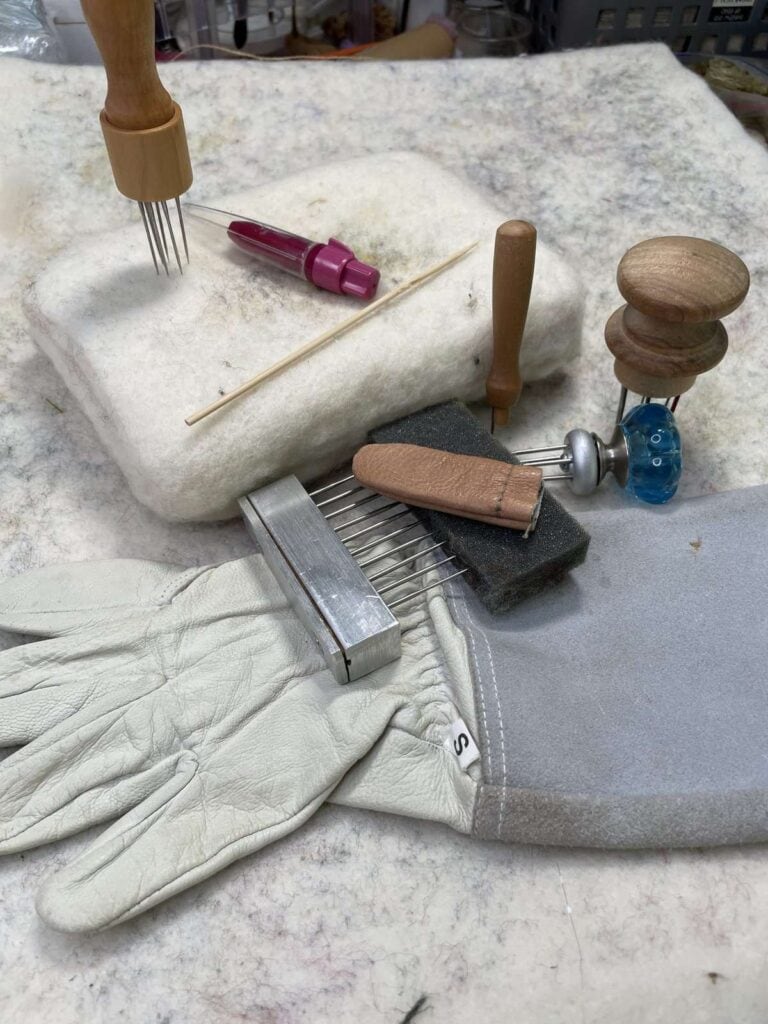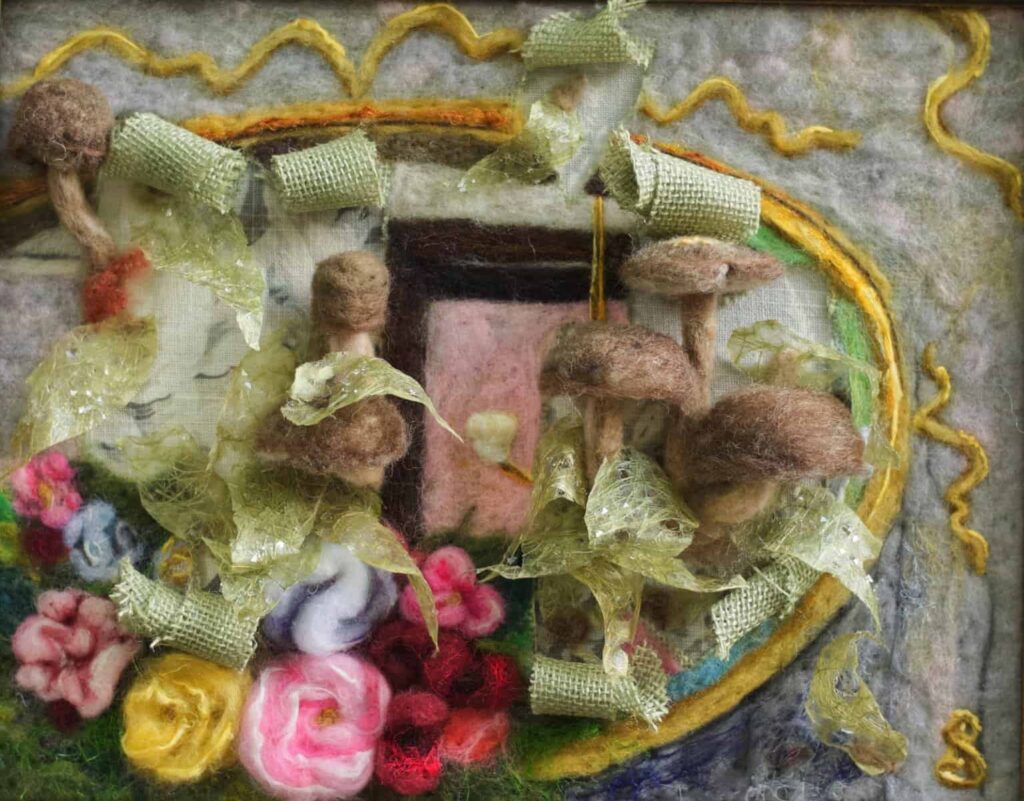Is needle felting dangerous? A felting fiber artist answers
Is needle felting dangerous? Yes, it’s true, needle felting can be dangerous, but it doesn’t have to be. Here are some of the safety tips and tricks I’ve learned as a felting fiber artist.
Like anything else folks set out to do, the more you know about the tools, material, techniques and yourself, the easier it is to avoid trouble.
So let’s jump right in…. Uh to the information that is!

Felting history
Needle felting is a relatively new fiber art, or fibre for folks in the UK might say. Originally it was something of an upgrade from industrial wet felting. Dry felting, as we call it now, developed from machine felting which revolutionized the market in the mid 1800s.
This is important, because the industrial process wasn’t particularly interested in hand safety, it was interested in speed and large scale. As a result, felting needles are not designed to be hand held.
Now, this is a hurdle that we can easily overcome. By using additional felting needle tools, or making other adjustments, making needle felting safer is absolutely an achievable goal.
Felting tools
Making needle felting safer begins with knowing your tools. First, let’s introduce the needles, ahem, the sharp needle tools we use to make dry felt.
There are several different types of felting needles, and they come in different sizes as well.
The shank of the needle comes in three major types, triangle, star and spiral. All of these types come to very sharp needle points. All felting needles also have barbs, and it is the barbs that tend to make injuries extra painful. And they come in various gauges from rather thick to extra fine.
While barbs are great at catching loose fibers and driving them deep into a pile, that’s not ever what you want happening to your hand or skin.
If I was only going to do one thing to make needle felting safer, it would be to invest in a leather gardening glove for my off hand. I personally have a gauntlet. While I don’t use it as often as I probably should, it takes all the fear out of needle felting for me.
With a leather glove it is easy to hold an entire mound of wool fiber and work needle felt directly in my hand. A basic shape for a 3d projects is a breeze when you can work right in your palm. This is the gold standard for safety equipment.
When you’re first getting started, many people will get a needle felting kit. These can be helpful, and they can give you a good start with basic safety tools if you’re not ready to invest in a leather glove, which alas, must be bought as part of a set.
Many dry felting kits come with finger protector sheaths. These can serve a similar purpose to a glove, if you are otherwise felting something flat, like a wool painting. These are nowhere near as protective or useful as a glove, but if you are the sort of person that hates having your hands covered this might be the right choice for you.
To get the most out of finger protector sheaths, you will also need a felting pad or felting mat. Felting pads give you a surface to felt onto. Not only do they protect the surface below, like your legs if you happen to felt while watching TV, but they also provide support to the sheep wool or other fibers you’re working.
A good felting pad is essential for wool painting. Or if you’re using a finger protector instead of a glove, a felting pad is also necessary, even if you’re working on a 3D object.
Felting pads can be made of foam. However foam is not my favorite. Over time foam wears down and can’t be repaired. In my opinion, the best ones are made of sheep wool. I make my own felting pads using layers of wool felt I buy from the fabric store right off the bolt. But there are more wool felting mats coming to market these days, so shop around.
The last thing that makes a big difference in needle felting safety is working with a needle holder or felting needle tool. Since felting needles were not made to be hand held, using a wood hold, or other needle felting tool, will make the needles much easier to maneuver.
Holds can fit just a single needle, or you can buy some that accommodate as many as 12 or more needles. Whatever you’re working on, a good needle holder will give you a better grip and more control. That all adds up to safer needle felting.
Felting Technique
Good felting technique not only makes needle felting safer, it can also save you money!
Felting needles take a lot of abuse. While eventually that will lead to needle breakage, you can make your needles last longer by making sure you keep your felting needle at 90 degrees from the surface of your felting pad.
Carefully working perpendicular in a smooth up and down motion is the best way to reduce needle breakage, especially when you are using extra fine size 42 felting needles or anything close to that delicate.
Broken needles are not just expensive, if you happen to be working without finger protectors or a glove, they could become a loose sharp object lodged in your hand, or floating around your workspace until you find it some other unpleasant way.
If you felt using good technique loose needle parts are much less likely to run amok when you break a needle, because A) your off hand is safer and B) a straight up and down motion doesn’t create the torque that would launch a piece of needle.
Now a little dirty secret. I often work my needle at an angle to achieve the effect I’m going for, because sometimes that’s what you need to do. So these are guidelines, not laws. Just use your judgment as you gain experience.

Pro-Tips
What if you forgot your glove, and your finger protector and you still want to needle felt? In a pinch, you can also use a bamboo skewer to hold your wool roving, carded wool, or other fiber in place while you felt into it. Into a felting mat, of course.
You can also use an ice pick, metal skewer, or marshmallow holder for the same purpose. Don’t be afraid to experiment with ways that will keep your fingers safe.
Say your needle felting kit came with needles, but not a hold to make the sharp needle easier to grip? If you have some Sculpey or other polymer clay lying around, and I know some of you do, you can use it to make a disk for gripping at the top of the needle.
Just roll a small ball, and then smash it over the bent top of the needle. Once it’s fired and dried it is much easier to hold than a bare needle.
As a side note you can also experiment with fiber. Raw wool, yarn, an old bit of knitting or even the remains of a wool sweater can be felted in too. Use your imagination and experiment.
Is Needle Felting Dangerous? Conclusion
Is needle felting dangerous? Maybe, but it doesn’t have to be. Using the right tools and techniques, needle felting doesn’t have to be dangerous at all.
So whether you’re a beginner or a fiber artist, working with a fine needle and wool roving, or your first needle felting project with core wool and a base fabric, you can keep your hands out of trouble and have felted wool in short order.
However you needle felt, it’s probably still safer than cave diving, bull riding or even keeping actual sheep, so maybe a little perspective is the best protection. Have fun out there.
Would you like to see more of my writing? Try a story snack or a poem. Both are low-calorie and good for the heart. Coming to the Eastern TN area? Check out my directory of fiber art attractions.
Like this writing and want to see more? Your donation will help me maintain and expand this site.
